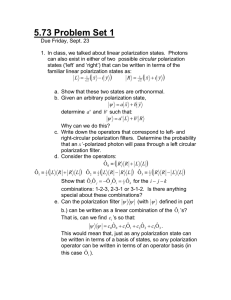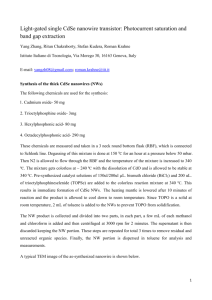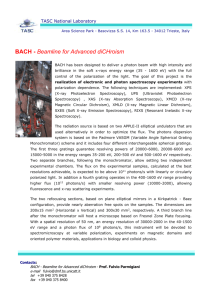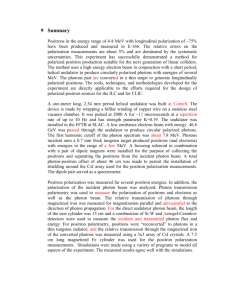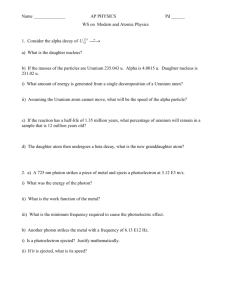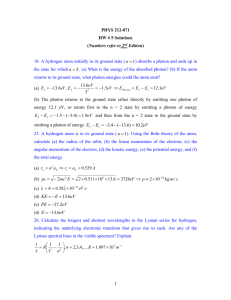BACH, the Beamline for Advanced diCHroic and scattering
advertisement
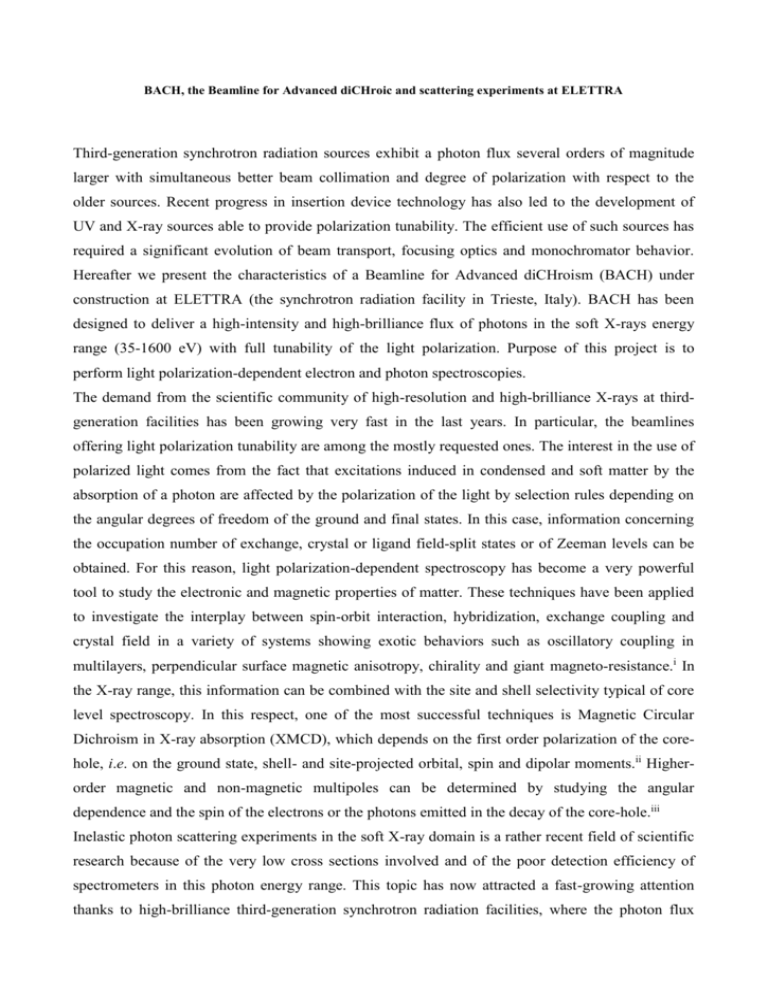
BACH, the Beamline for Advanced diCHroic and scattering experiments at ELETTRA Third-generation synchrotron radiation sources exhibit a photon flux several orders of magnitude larger with simultaneous better beam collimation and degree of polarization with respect to the older sources. Recent progress in insertion device technology has also led to the development of UV and X-ray sources able to provide polarization tunability. The efficient use of such sources has required a significant evolution of beam transport, focusing optics and monochromator behavior. Hereafter we present the characteristics of a Beamline for Advanced diCHroism (BACH) under construction at ELETTRA (the synchrotron radiation facility in Trieste, Italy). BACH has been designed to deliver a high-intensity and high-brilliance flux of photons in the soft X-rays energy range (35-1600 eV) with full tunability of the light polarization. Purpose of this project is to perform light polarization-dependent electron and photon spectroscopies. The demand from the scientific community of high-resolution and high-brilliance X-rays at thirdgeneration facilities has been growing very fast in the last years. In particular, the beamlines offering light polarization tunability are among the mostly requested ones. The interest in the use of polarized light comes from the fact that excitations induced in condensed and soft matter by the absorption of a photon are affected by the polarization of the light by selection rules depending on the angular degrees of freedom of the ground and final states. In this case, information concerning the occupation number of exchange, crystal or ligand field-split states or of Zeeman levels can be obtained. For this reason, light polarization-dependent spectroscopy has become a very powerful tool to study the electronic and magnetic properties of matter. These techniques have been applied to investigate the interplay between spin-orbit interaction, hybridization, exchange coupling and crystal field in a variety of systems showing exotic behaviors such as oscillatory coupling in multilayers, perpendicular surface magnetic anisotropy, chirality and giant magneto-resistance.i In the X-ray range, this information can be combined with the site and shell selectivity typical of core level spectroscopy. In this respect, one of the most successful techniques is Magnetic Circular Dichroism in X-ray absorption (XMCD), which depends on the first order polarization of the corehole, i.e. on the ground state, shell- and site-projected orbital, spin and dipolar moments.ii Higherorder magnetic and non-magnetic multipoles can be determined by studying the angular dependence and the spin of the electrons or the photons emitted in the decay of the core-hole.iii Inelastic photon scattering experiments in the soft X-ray domain is a rather recent field of scientific research because of the very low cross sections involved and of the poor detection efficiency of spectrometers in this photon energy range. This topic has now attracted a fast-growing attention thanks to high-brilliance third-generation synchrotron radiation facilities, where the photon flux must be maximized to the detriment of energy resolution to have significant counting rates. These techniques have been extensively applied to the investigation of core-excited states and of the dynamics of decay processes in condensed matter.iv With the help of circularly polarized light, they have also been employed to study element-specific moments as well as their energy distribution in the valence shell. The beamline optics has been designed to work either in a high brilliance mode, which is needed for scattering and fluorescence experiments, or with a highly monochromatic beam, necessary for absorption and photoemission measurements at high resolution. The possibility of switching between these two operating modes is offered by the beamline monochromator, where three gratings cover the whole accessible photon energy range with high resolving power, while a fourth grating, with a low groove density, covers the high-energy range with high efficiency. In the following paragraphs we describe in details each component of the BACH beamline, giving relevant estimated optical characteristics such as resolving power, photon flux and density, higher order rejection rate, etc. 9.25m 2.75m Top View 6.5m Exit Slit (S2) Vertical focus Entrance Slit (S1) Focus in both directions SM2 U1 U2 PEM2 B PEM 1 SG1-4 PM1 PEM1 B SM1 1m 8.8 º PEM2 7m 1m 1.5m 6m 15.5m i 1.65m 8m 4m See, for instance, “Synchrotron Radiation and Magnetism”, edited by E. Beaurepaire, B. Carrière and J.P. Kappler, Edition de Physique (1997). ii P. Carra, B. T. Thole, M. Altarelli and X. Wang, Phys. Rev. Lett. 70, 694 (1993). iii G. van der Laan and B. T. Thole, Phys. Rev. B 52, 15355 (1995); J. Phys.: Condens. Matter 7, 9947 (1995). iv See, for instance, F. Gel’mukhanov, H. Ågren, Physics Reports 312, 87 (1999).
